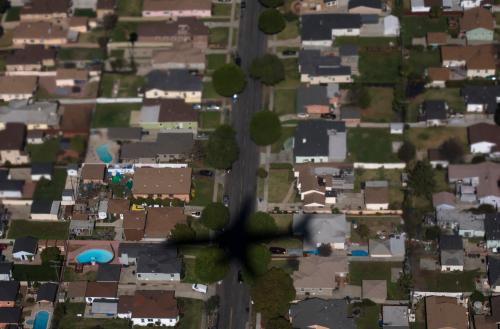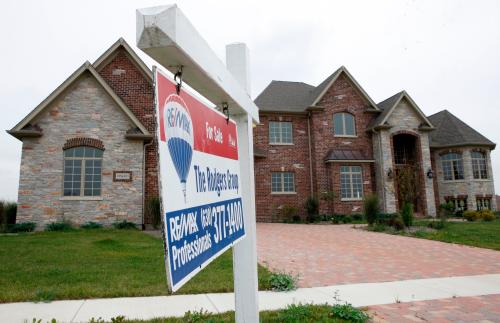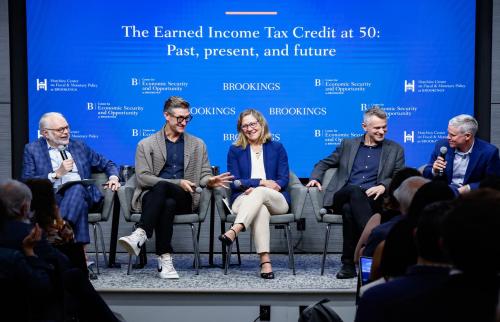The state of the American middle class is a hot topic on the campaign trail and in the policy community. As we have shown before, income growth for the middle class, defined as the middle 60 percent of the income distribution, is falling behind both the bottom and the top. Using the Congressional Budget Office’s measure of income after taxes and transfers, which takes into account market income, social insurance, federal taxes, and means-tested transfers, middle-class incomes have grown 47 percent from 1979 to 2016.
That growth pales in comparison to the top and the bottom. The top 20 percent has seen their incomes double. But much more surprisingly, the bottom 20 percent has seen income growth of 84 percent, far outpacing the middle class. Plus, these trends are predicted to continue.
Measuring income is a tricky business. A reasonable critique of this approach is the inclusion of the value of health insurance subsidies, especially for those at the bottom of the income distribution. The value of these insurance subsidies, and therefore the value added to a poor family’s income, has grown faster than other components of income over the past several decades. Some of that additional income bought better healthcare but some did not. More importantly, health insurance can’t be used to pay the rent or buy food, and many if not most of these low-income families would likely value this coverage at less than its high cost. Recognizing the problem, previously, CBO used the “fungible” value of Medicare, Medicaid, and CHIP, which values government insurance to the extent it frees up other income to spend outside of necessities. Then, starting in 2012, CBO began counting the full per capita cost to the government of providing that insurance as income.
This debate about how to count government subsidized health insurance in measures of income has not been fully resolved. Does giving low-income families access to healthcare really increase their income? Some argue yes. If the cost of that access is $7,000, and the family would otherwise have had to buy an insurance policy costing that much, then government provision is worth a lot. Moreover, those are real federal dollars funded by taxpayers and should be counted. Others argue that, in the absence of government provision, most of these families would never buy such an expensive insurance policy for the simple reason that they can’t afford it. They likely value other goods and services more, especially if they are relatively healthy and do not utilize the full value of government insurance.
While we will not solve that debate here, we do want to make a point about the role of healthcare in the CBO numbers. CBO includes three measures of healthcare income: Medicaid and CHIP, Medicare, and employer’s contributions to health insurance.[1] Government subsidies for health insurance make up a large portion of the bottom quintile’s income growth over the past 40 years, largely due to Medicaid and CHIP as mentioned above. Excluding all government and employer health insurance subsidies, the bottom quintile’s income growth drops from 84 percent to 40 percent—a huge decrease.
However, excluding healthcare affects income growth throughout the income distribution. Without healthcare, middle class income growth decreases from 47 percent to 32 percent, a sizable decrease.
Regardless of your view on the healthcare question, income growth for the middle class is still falling behind both the rich and the poor. To be sure, the bottom quintile started from a much lower base in 1979. We are not suggesting that those at the bottom are doing just fine. However, we are arguing that the middle class has not seen strong income growth relative to other groups.
[1] CBO also includes low-income subsidies for Part D of Medicare and payments for cost-sharing reductions as part of the Affordable Care Act. In the public data, these two elements are lumped into a catch-all category, “Other Transfers,” so cannot be separated out for this exercise. Inclusion of the ACA subsidies likely biases the estimate for income growth of the middle class upwards. Inclusion of the low-income subsidies for Part D of Medicare likely biases the estimate for income growth of the bottom quintile upwards. These two additional healthcare elements are small compared to Medicaid and CHIP, Medicare, and employer’s contributions to health insurance.
The Brookings Institution is committed to quality, independence, and impact.
We are supported by a diverse array of funders. In line with our values and policies, each Brookings publication represents the sole views of its author(s).








Commentary
Middle class income growth is lagging the rich and the poor—how much is due to healthcare subsidies?
January 21, 2020